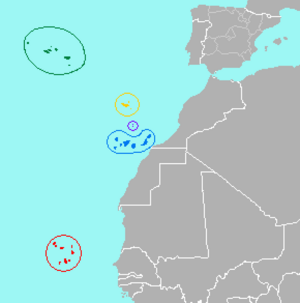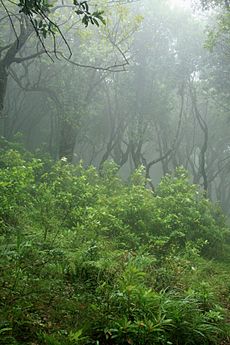Macaronesia facts for kids
The Macaronesian islands, often called simply Macaronesia, are a group of islands in the Atlantic Ocean. They are off the coasts of Europe and Africa. These islands were formed by volcanoes. They belong to three different countries: Portugal, Spain, and Cape Verde.
Contents
Where the Name Comes From
The name Macaronesia comes from ancient Greek words. Makáron means 'blessed' or 'happy', and nêsoi means 'islands'. So, it means 'blessed islands' or 'fortunate islands'. Ancient Greek geographers used this term for islands west of the Strait of Gibraltar.
A botanist named Philip Barker Webb started using the term Macaronesia in the 1830s. He used it to describe the plants found on these islands.
The Islands of Macaronesia
The Macaronesian islands are grouped into several archipelagos. They are listed here from north to south:
Portuguese Islands
- Azores (
 Portugal): This group has an area of 2,333 km2 (901 sq mi). About 245,746 people lived there in 2012.
Portugal): This group has an area of 2,333 km2 (901 sq mi). About 245,746 people lived there in 2012. - Madeira Islands (
 Portugal): These islands cover 801 km2 (309 sq mi). In 2011, about 267,785 people lived here.
Portugal): These islands cover 801 km2 (309 sq mi). In 2011, about 267,785 people lived here.
Spanish Islands
- Canary Islands (
 Spain): This is the largest group, with an area of 7,493 km2 (2,893 sq mi). In 2011, about 2,117,519 people lived there.
Spain): This is the largest group, with an area of 7,493 km2 (2,893 sq mi). In 2011, about 2,117,519 people lived there.
Independent Country
- Cape Verde (
 Cape Verde): This country has an area of 4,033 km2 (1,557 sq mi). An estimated 523,568 people lived there in 2013.
Cape Verde): This country has an area of 4,033 km2 (1,557 sq mi). An estimated 523,568 people lived there in 2013.
People in the Canary Islands speak Spanish. On the other islands, they speak Portuguese. Cape Verde used to be a colony of Portugal. It became an independent country in 1975.
Geography and Environment
The Macaronesian islands were all formed by volcanoes. Scientists believe they were created by several geologic hotspots. These are places deep within the Earth where hot molten rock rises to the surface.
The climate across the Macaronesian islands varies a lot. The Azores and Madeira have a Mediterranean climate. This means they have cooler temperatures and more rain. Cape Verde, however, has a very arid (dry) climate.
Even though the islands are far apart, they share similar plants and animals. Many plants are endemic to these islands. This means they are found nowhere else in the world.
The islands have a special biogeography. They are home to unique plant and animal communities. One special type of forest is the laurel forest, known as laurisilva. These are mountain cloud forests. They have plants that once grew across much of the Mediterranean area. These plants adapted to the island conditions. These forests once covered most of the Azores, Madeira, and parts of the Canary Islands. They grew at altitudes between 400 and 1200 meters. The eastern Canary Islands and Cape Verde were too dry for these forests.
Conservation Issues
Many native plants have been lost on the islands. This happened because people cut down trees for timber and wood. They also cleared land for grazing animals and agriculture. New plants and animals brought by humans have also caused problems.
The beautiful laurisilva forests have shrunk to small areas. Because of these changes, many of the unique plants and animals of the islands are now seriously endangered. Some have even become extinct.
Images for kids
-
Remaining patches of Macaronesia's threatened primeval laurisilva forest (except in Cape Verde) were protected by EU law in 2001.
See also
 In Spanish: Macaronesia para niños
In Spanish: Macaronesia para niños





